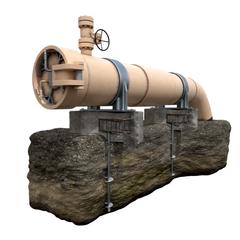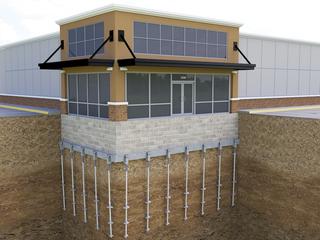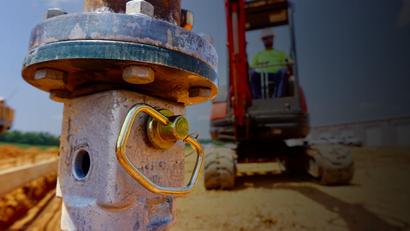Deep Support for Foundations
Commercial foundations require deep, reliable support—especially when surface soils are weak, expansive, or inconsistent. These conditions can lead to settlement, loss of bearing capacity, or structural damage over time. Helical pile installation transfers loads to stable soil layers or bedrock using steel piles installed with small equipment. This method is ideal for commercial properties, tilt-up buildings, and additions where conventional excavation is impractical or disruptive.

What Is Helical Pile Installation?
Helical pile installation is a deep foundation method that uses steel shafts with helical plates to transfer structural loads to competent bearing soils. The piles are rotated into the ground using hydraulic torque equipment and anchored at depth based on load requirements.
In commercial applications, helical piles are used to support foundations on soft or expansive soils, underpin settled structures, or build new foundations in limited-access environments. They are a preferred option for tilt-up buildings, interior footings, and locations with poor soil records.
Where Might Helical Piles Be Needed?

- Tilt-up buildings with settlement at exterior walls
- Additions built next to aging structures
- Sites with variable fill or undocumented soils
- Foundations over expansive clay or organic layers
- High water table zones
- Column pads supporting heavy interior loads
- Projects with tight timelines requiring fast stabilization
- Buildings impacted by nearby utility trenching or sitework
We Recommend Helical Piles If You See:
- Visible foundation movement or cracking
- Settlement concentrated at structural corners
- Undocumented fill or poor compaction under a new build
- Plans to expand onto soft or disturbed soil
- Slabs separating from perimeter foundations
- Soil reports indicating inadequate bearing strength
- Support needed for mechanical pads or point loads
- High-risk conditions for traditional shallow footings
- Load increases for retrofitted equipment
- Ongoing water infiltration softening soils below footings
Is Helical Pile Installation Really Needed?

Yes. Helical piles offer a reliable solution when soil conditions pose a risk to structural stability. They are particularly effective in commercial projects where fast installation, low-impact access, and real-time performance verification are essential.
For tilt-up buildings and slab-on-grade facilities, helical piles provide deep structural support without large excavation zones or extensive disruption to daily operations.
What Are the Advantages of Helical Piles?
Built for the demands of commercial construction and repair.
Reliable Deep Support: Transfers loads to competent soils below weak surface layers.
Real-Time Load Verification: Torque monitoring ensures piles meet performance specifications.
Minimal Access Requirements: Installs with small equipment and controlled excavation.
Fast Installation: Projects often completed in days with no cure time required.
Adaptable for New or Existing Structures: Works equally well in construction or retrofit environments.
Common Problem Areas
- Tilt-up foundations with shifting wall panels
- Fill zones with poor or variable soil compaction
- Column footings and load pads on weak soil
- Expansive clay regions
- Retrofit support for mechanical or racking systems
- High-moisture or erosion-prone subgrades
Build on Solid Ground with Groundworks’ Helical Pile Solutions for New Construction.
How Does Helical Pile Installation Work?
Each step is engineered for accuracy and minimal disruption.
- Review geotechnical reports and structural loads
- Design pile layout based on capacity and spacing
- Prepare targeted excavation at footing or slab locations
- Mobilize compact hydraulic torque equipment
- Install piles to depth and torque specifications
- Attach brackets or caps for load transfer
- Lift or support structure if required
- Confirm stability and alignment
- Restore site to maintain operational continuity
Why This Is the Best Choice

- Immediate structural support—no wait time
- Installs in confined, active, or interior spaces
- Limits excavation to specific footing locations
- Compatible with polyurethane injection where needed
- No concrete curing or mass trenching
- Maintains access and use of the site during installation
- Trusted by engineers for commercial applications
- Backed by load data and performance records
Contact Groundworks for Helical Pile Installation
Helical Piles for Commercial Foundations
Groundworks provides deep foundation systems using helical piles for commercial, industrial, and public infrastructure. We support tilt-up buildings, multi-tenant facilities, and structural retrofits with engineered deep support solutions. Schedule an on-site assessment today.
Names You Know Trust Groundworks with Their Toughest Foundation Issues





We want to learn about your project.
FAQs
It depends on soil conditions—piles are driven until they reach required torque, often 10–30 feet deep or more.
Yes. Compact equipment and minimal excavation allow for interior installation with little disruption.
Absolutely. Helical piles are ideal for both foundation repair and new construction on poor soils.
We use compact, high-torque hydraulic equipment to install piles with precision.
Helical piles install faster, with less noise, vibration, and site disruption—especially in light-to-moderate load commercial projects.
Disclaimer / Terminology
Helical Pile: A steel shaft with helical plates used to support loads at depth.
Torque Specification: A measurement used to confirm the pile has reached load-bearing strata.
Load Transfer Bracket: Steel component that connects a pile to the structure.
Settlement: Downward movement of a structure due to loss of soil support.
Targeted Excavation: Controlled digging to expose footings or create access for installation without disturbing the surrounding site.